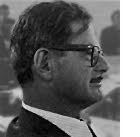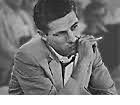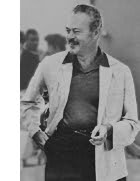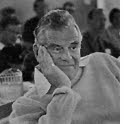|
|
Film — The Andromeda of the Arts
Lionel Trilling, Author, Critic, Columbia University Professor
Ever since its earliest beginnings, the cinema has been thought of as potentially the great art of the future; and as its technical resources have proven, more and more has been. expected of it, once it was liberated. Once it was liberated — for the cinema, if it was ever born free, is everywhere in chains. It is the Andromeda of the arts, and many men of great talent have wished to be its Perseus.
In this, its situation is unique. Surely in all the history of culture, there is no other example of an art coming to so high a point of technical and aesthetic development without gaining full autonomy—at the risk of being pretentious, I will say without gaining full spiritual autonomy. We are all aware of one reason—a chief reason—why this is so. No other art ever was an industry before it was an art. And if I understand what is happening in the new world of film, there is a new and very intense effort being made, under new economic conditions which give reasonable expectations of success, to overcome the financial controls which have limited the artists of film in their right to say what they think ought to be said, to show what they think ought to be shown.
But if we are immediately aware of the economic circumstances that have made for the bondage of the cinema, we cannot fail to see that these are connected with cultural circumstances. It is obvious that, of all mediums, the cinema is the one most appropriate to a democratic society, to large egalitarian populations. And the limitation of autonomy which the cinema has endured has, of course, been imposed by the effort of financial interests to satisfy—or at best to circumvent—the taste and preferences of large egalitarian populations.
But something has happened to the tastes of our large populations. For one thing, they have become generally more complex, or refined, or adventurous. For another thing, they have become diversified and segmented, and it is to be observed that certain segments of new taste are in themselves sufficiently populous to support artistic activities of, as we say, a very advanced kind.
These new circumstances of taste are very impressive. They constitute something like a revolution in culture. And it is surely clear to us that a leader in this revolution is the cinema itself.
Yet a literary critic, looking at the prospects of the cinema in all their brightness, might presume to utter one word of warning. The revolution in taste of which I have spoken is a very notable event in our culture and no doubt it is a happy event. But I think we should be aware of an aspect of this event that is not happy: with the new acceptance of high and advanced art has come a new imperturbability to art.
We might say that because nothing can shock our taste, nothing disquiets our minds. In the public rooms of the Hilton Hotel in New York, the walls are hung with excellent paintings by very distinguished contemporary artists, the members of every brilliant extreme school of our time. Many of these works are, as I read them, profoundly subversive, and admirable as such. The cultural level of the guests of the Hilton Hotel may be described as being that of people who choose to be the guests of the Hilton Hotel. To these people the pictures offer no shock, no affront. They are accepted as part of the decor, as a very charming, pleasing, flattering part of the decor, to which no meaning need be attached.
I am not so naive as to think that when cinema aspires to be a great art, its aspirations are wholly defined by the qualities of great literature. It is also a graphic and plastic art, and to a greater degree than the stage drama. But it is also a literary art, it is also an art whose substance is the moral life of man. And the literary arts, I think, transcend the bounds of what we call taste. That which we identify as greatness in literature may indeed be associated with charm and pleasure, but it is chiefly associated with what is perturbing, even with what is distressing. It is associated with moral discovery, and to that rough and troubling enterprise it has willingly sacrificed charm of surface, even symmetry of form. My fear for the cinema is that, as it moves ahead in its new freedom which the revolution in taste may be providing, it will give us works of great brilliance and originality which will flatter our tastes and our wonderfully enlightened new prejudices, works that will not trouble us in the least.
As I say this, I should make it plain that I do not speak from the height of any great satisfaction with literature as it now exists. Some years ago we cam to the end of a great classic epoch of literature, the epoch of Joyce, Lawrence, Proust, Gide, Kafka, Mann, men who shook our souls and distressed our minds with the newness of what they had to say and the way they said it. However much we try to convince ourselves of the contrary, no one has followed in their path—at least for the time being.
The essential quality of literary greatness, telling the truth about life, is in abeyance. Perhaps that sad circumstance will make it easier, not harder, for film to achieve now its own greatness, if that is what it wants. 
If We Have to Bury You...
Stanley Hirsin, Film Maker
The only progress that's going to come is when the old film makers realize that the young film makers just want to make good films. If we have to bury you, it's only by necessity. We're much younger. It's not capitalism versus communism. We have to inherit Hollywood, one way or the other, and the fact that we do, means that we want to change it, we want to create our own Hollywood, we want to create our own way of making films. 
Advice from Abby
Abby Mann, Screen Writer
I just say to you young film makers, do the things that you feel most deeply, because I think that's the best chance of it being done. 
Crossroads: To Mold the Higher Tastes or Pander to the Lowest
Norman Corwin, Author, Dramatist

It is clear from both sides in Hollywood that new blood is needed, but not wanted. The desire is there, but the consummation is only devoutly to be wished, and nothing more.
Now this situation is enough to pique the curiosity of anyone. How does it happen? Are the young men without portfolio so different from the Ins who man the Establishment? Is each exotic to the other? On both sides there is acknowledged talent; both want to make good and profitable products. Yet there are obviously deep differences. A big one is in the degree of artistic security. The entrenched industry, having access to banks and millions, is nevertheless too often artistically insecure, whereas the young film maker, often hard put to raise the cost of raw stock and camera, is at least free to shoot what is on his mind and in his heart, and thus, in a lonely and melancholy way, he is relatively secure in his art.
One might think the Establishment would be confident, even arrogant, in its own powers, but even in its heyday it was timid about material. Hollywood has mostly preferred that some other medium initiate, test, and prove out its artistic resources; that somebody else take the risks and pains of conception and trial, be it the stage with the hit play, the publisher with the best-selling novel, the magazine serial with the giant circulation to build up titles, or the celebrity marinated in publicity (whether Sinatra up from radio, or the Beatles up from England, or an ex-queen from Iran).
The caution was, and is, understandable. Nobody wants to lose his shirt, least of all a shirt with corporate studs. But the fear of failure can be more crippling than failure itself. There is at least one incumbent major studio executive head of a rich and powerful film company, whose terror of failure is so crippling that only the safe, routine, pretested, undistinguished, competent, journeyman picture may be made in his plant.
To get back to the young film maker: as against the company, he has no qualms about trying something new. As a rule he couldn't dream of buying a hit play or a best seller; he couldn't afford Audrey Hepburn's stand-in. He is unencumbered by stockholders, a board of directors, or any of the disorders of corporate metabolism. His wife may object to his cashing in an insurance policy to cover lab costs but he is saddled with no idle sound stages that add to his overhead; he has no backlog of unproduced screenplays in which he has invested a fortune; and he is beyond the purview of the Legion of Decency. If his leading actress catches pneumonia or his male star is caught in a dope raid, it is no irrecoverable disaster. He will never need to peddle his old pictures to the late late show, or sell off his back lot to Zeckendorf.
Small wonder, then, that he creates new, different, arresting films. He had better, if he is to assert himself at all. Nor is every young film maker an unsung genius. Some of them are genuine hacks, and the fact that they are young and not profitably employed does not necessarily make them splendid and wise. If a man is to be an artist worthy of the name, it behooves him to sail on a fresh tack. He can afford to.
The Establishment admits that it will have little to do with the young men. On the other hand, the industry should not forget that its senior craftsmen, even though they may not admit young men to their ranks, do admit their ideas and influence. Orson Welles was just such a young man when he made "Citizen Kane"; no one can deny its effect on subsequent films. Eisenstein was twenty-five when he made "Potemkin", Chaplin was twenty-four when he captivated his first audience; Griffith was in his twenties when he first hit.
Pictures like "The Hustler," "Hud," "Tom Jones," and "A Hard Day's Night" represent a cross-fertilization of ideas and styles and philosophies of film—in them are glimmerings of all the young forebears, the experiments with hand-held cameras and bold cutting and diffused focus and piercing depth and overcranking and undercranking and whole new domains of story-telling. There is interaction between the young Outs and the old Ins, whether acknowledged or not.
But while the young film maker looks up to the seat of the mighty with envy and often with admiration, he no doubt regards its economy with amazement. For there the Establishment seems slowest of all to learn. To this day it clings, almost poignantly, to legends and traditions of the past. The star system is slavishly honored and employed, in spite of some of the most titanic disasters since the sinking of the ship of the same name.
The young film maker surely is aware that the day in which a star was a guarantee of box office returns is over. He is aware that if a film has no story or lacks a formidable premise, the producer is in trouble. He is aware that Yul Brynner will not, by the magic of his name and talent alone, make a hit of "Flight to Ashiya"; that even John Wayne, for so long a box office champion, and John Houseman, master director, could not combine to make a winner when the story was not there. The young film maker knows all this, but I'm not sure the Establishment quite believes it.
Finally, any consideration of the young film maker and his contemporaries must take into account the audience, which is, after all, the ultimate arbiter of what succeeds commercially. One may well ask whether the American audience would support the young film men, if they exposed their work. If the young Outs, instead of being denied even rudimentary distribution as of now, were to have their work broadly exposed, would many of the public show up? Or come back for more?
The answer to this, as to any imponderable of our culture, lies in the broadest configurations of society. If the instruments of artistic communication, the movie studios, theatres, transmitters are in the hands of timid or venal men, if mediocrity and a low mean are deliberate because they also are profitable and a way of life; if "Beverly Hillbillies" is eternal while "East Side, West Side" dies like a pedigreed dog; if monster and nudie movies are to be seen every night of the week in all of our key cities, while the "Spirit of America,'' and "Robert Frost," and a hundred other serious and wellmade films can't get a play date; if telephone and disk jockeys flourish while good music and drama are exiled to the remotest wave lengths of FM and the ghettos of educational radio, if one and the same mammoth corporation is to own a network, a recording company, "My Fair Lady," and the New York Yankees, while no young film maker can get past one of its secretaries to sell it a film like "Dream of Wild Horses," or Carson Davidson's "Variations on an Italian Theme"; if the Beatles take ten million dollars out of the United States while the symphony orchestras of the land scrabble for support, then something is wrong at the base of the pyramid, and not alone at the top. And there is very small hope that the young film maker will ever climb higher on the totem pole, unless our culture is strengthened to the point where he is looked upon as an honorable and useful artist, instead of an oddball.
The late, great Walter Paepcke, founder of the Institute under whose roof we meet, was partial to this sentence of Plato: "What is honored in a country will be cultivated there." The task is progressive—to cultivate that which is worthy of honor, and then to honor it.
Education can help, of course, but we can't wait for Summerhill and Harvard and the Aspen Institute and the Federation of Film Societies to do it all. It is the option, if not the duty, of mass communications to lead more than to follow to mold higher tastes rather than pander to the lowest. 
The View from the Front Office
Robert Blumofe, VP, United Artists
What is the Establishment? Who is in it? How does it function?
For example, am I part of the Establishment? I am Vice President in charge of West Coast Operations, and as such, in charge of West Coast productions for United Artists, one of the major motion picture companies. I am also the man (and when I say 'I', I mean myself and my associates at United Artists) responsible for the making of such films as "Marty," "Twelve Angry Men," "Never on Sunday," "Tom Jones," "Lilies of the Field." So what am I, a sponsor or stifler of creativity in film making? I am responsible for giving a first chance or first major chance in theatrical film making to young Americans like Dennis and Terry Sanders, John Frankenheimer, Sidney Lumet, Delbert Mann, Stanley Kubrick, Ralph Nelson, and others.
Now, to the young picture makers here, I say, "What's your beef? That we don't do this often enough?" I agree. I would like to do it more often, but it is as much your fault as mine that we don't. I am constantly looking for this kind of project. . . but they are as scarce as hen's teeth, and even with the ones we take on, our average of success isn't very good.
I succeeded with "Lilies of the Field," but I failed with "Ladybug, Ladybug," with "War Hunt," with "The Explosive Generation," and with other pictures. I am no good to anyone, I can't even stay in business if, over-all, I don't show a profit.
Let me tell you some of the facts of life—my facts of life, and I think yours. Films are made with financing obtained from banks and other lending institutions. Banks are not in the habit of lending money on individual pictures. They tried this once and got badly burned. Today, they lend only on the success record and the financial responsibility of a company like United Artists making a multiple picture program. They lend on United Artists' guarantee of their money and not on whether they think an individual picture will be a success or a failure.
To give you an extreme example, and I promise, it is a true example, if Billy Wilder went to a bank with his own screenplay, with Elizabeth Taylor and Rock Hudson as the stars, and a valid budget of one million dollars, he could not get the money. The banks simply are not in that business.
They know, on the other hand, that over a twelve-year period they have never taken a penny's loss on a single United Artists picture, because if the individual picture failed, United Artists made good. But we can make good overall only if our judgment as to the commercial potential of our pictures is more right than wrong. Of course, as you all know, we are a publicly owned company, and we are legally bound to operate the company in the best financial interests of our stockholders. I am not saying we do not owe an obligation to young film makers. We do, but this is not our only obligation nor even our over-riding obligation. We have a tough job of meshing our various responsibilities. We don't always succeed and, unfortunately, you probably think that we don't even try. But we do.
We talk about the motion picture industry, but I say there is no such thing. What we have is a group of film companies in cutthroat competition with one another. Every time there has been talk of a program that would benefit the industry as a whole, it has foundered on the greed and selfishness of the individual companies. And that is the main reason why we don't have a comprehensive and intelligent industry-wide program for the induction, training, development, and use of young film makers and other young talents. 
The Role of the Audience
James Blue, Film Maker

What we need as young film makers, or simply as people trying to exercise another part of the possibilities of the art of film, is a growing awareness on the part of the audience of what is being done and what is possible to be done in the film.
I think what we young film makers want is an audience. But we don't feel that we have to make a certain kind of film to find an audience. In other words, an effort has to be made toward expanding interest in the film as art. In that way more people would be interested in all areas of film expression, from whatever direction they might come. Film has so many possibilities. It has its realists, its dramatic callings, its calling to education. People have hardly begun the exploration in the graphic arts of film. 
Renascence in a Youthful Medium
Arthur Knight, Hollywood Museum Curator, and Saturday Review Film Critic

I suppose that every art form, and not just film, is afflicted with a relentless search for new methods of expression. Within this century you have seen the transformation of music from the dissonances of Wagner, the introduction of atonal music, the introduction of the twelve-tone scale and the rows, right down to the prepared pianos of John Cage. In art and painting, at the same time, we have journeyed from the experiments of the Impressionists. We have passed through Dada, Surrealism, and Abstract Expressionism right on to today's Pop Art.
So, in films, it is hardly a surprise that in this same century, which corresponds to the full growth of the medium, the movie makers had scarcely learned how to tell a story coherently before other film makers were crying to find new ways to handle the medium, new ways to look at the world around us with the camera.
It seems to be pare of the organic growth of any medium, this surge for new modes of expression. It is hard on the audiences often. We recall that even staid old Brahms was not immediately accepted by the audiences of his day, and I daresay many of us here in this room have had the experience of finding Stravinsky terribly difficult when first we listened to him, and now today we wonder what that difficulty was. As a matter of fact, works like "Firebird" and "Rites of Spring," which caused riots in their day, now seem curiously staid and, at least for me, the "Firebird" is even old fashioned to the temper of our ears now.
Film, however, still does seem able to provoke riots on occasion, or at least major disturbances. In Los Angeles when Andy Warhol's "Sleep" was presented at the Cinema Theatre, it caused just such a riot. We saw nothing but a man sleeping — for about six and a half hours. The audience was with it for perhaps the first fifteen or twenty minutes in which the single shot remained on the screen. Some of the audience stayed with it when, after about half an hour, we moved to another angle of the same man still sleeping. We knew it was a moving picture because he was breathing. It goes on that way, I am told, for the full six and one-half hours.
There was something terribly funny in the lobby. They had a display of an announcement of the film when it first appeared in Belgium, saying that it was an eight and one-half hour film, and they were only running six and one-half hours at the Cinema Theatre. Somebody wanted to know why they were daring to run a shortened version. The answer was that "he tightened it." In any case, it wasn't tight enough for most of the people at the Cinema, who not only demanded their money back, but some of them had to be restrained from running down the aisle and damaging the screen.
Pictures can still arouse in audiences the kind of passions that were once aroused by certain ballets, by the poems of Richard Strauss, by the music of Stravinsky. This to me is a very important thing, a healthy sign. There is always the danger of the too-easy acceptance of the new just for the sake of newness. If it is new, it is good, some people feel. I will go along with the reverse—that if it is good, it is new.
The idea of newness for its own sake, it always seems to me, is rather a questionable one. However, the true artist is the man who has a newness of vision. The man who is responding to the life around him must be working in an idiom that is not of another century, another country, or another time. With films, we have become particularly aware of the importance of this personal vision in the years since the war, and we have me personal visions of men like Bergman in Sweden, of Kurasawa in Japan, of Sayajit Ray in India, of Fellini in Italy, of al the New Wave film makers in France— people who have used the form, as it has been developed, of motion pictures, but who have stamped each of their films with a very personal feeling, with their own way of looking at the world, and their own way of handling the camera. As a result, it would be impossible, even if you take the credits out of the picture to confuse a film of Bergman's with a film of Sayajit Ray's, or a film of Fellini's with a film of Kurasawa's. There is the body of conventional film-making techniques, but these men have transformed it and used it to create their way of looking at the world.
If I may generalize, art—any art—constantly refreshes itself, because artists are making new statements that come out of their times and their reactions to their times. Ultimately, I feel it is not the newness that we prize, but the freshness of vision. When that truly exists, the newness, the strangeness, gradually falls away, as it has in the works of Brahms and Picasso, and we are responding to an artist's statement and not his technique. It may not be immediately apparent, but if it is there, we know very well the work has a good chance of surviving. 
It's Not What You Put In,
It's What You Leave Out
John Burchard, Dean, School of Humanities and Social Science (Retired ), Massachusetts Institute of Technology

Every artist has the purpose, in fact responsibility, to do his job exactly as he sees it, without any compromise. But this earns him exactly nothing from society. He can paint himself blue, he can dance naked in Times Square; and if he has to or wants to, and he may, be arrested—that's censorship. But he must not feel misunderstood if nobody watches him, if nobody drops a coin in his cup, or lays a chain around his head.
Second point: It's a mistake to divorce art from communication. I know of no durable art whatever which hasn't communicated, and which doesn't still communicate—and quite explicitly. It doesn't have to communicate with everybody, of course, but art is a dialogue, not a monologue. The artist says something, and the viewer reacts. Without the reaction, isn't any art.
Third, with rare exceptions (Shakespeare, perhaps ), artists who concern themselves with current problems generally are angry people, or else people very enthusiastic about things as they were. There really, for me, is an art. I think escape or dispassion is strictly for the birds, but if the art stops with current protest it will prove ephemeral. The great work operating to move the present will say something about the human condition, too, and that isn't ephemeral. If it doesn't, then it will go the way of Shaw, perhaps Dickens and Zola, and, I suppose, James Baldwin.
Fourth, artists shouldn't assume that because they fail to reach an audience they're misunderstood. They may be all too well understood. Most of the great artists of the past who are appreciated now were not unappreciated in their own times. This is one of the worst myths in the world. What they all wail at the box office is that Mozart died young and poor. Most of them were very successful in life. Very few of those whom we cherish today were misunderstood in their own time. Even among the handful who did go unapplauded in their own time, most of them weren't misunderstood, they were understood very well, but the messages were unpalatable.
To be sure, one of the reasons for rejection of art in this time is the momentary inability of audiences to cope with a new way of expression. But this is ephemeral. If in time "Firebird" seems dull, it's not because the medium of expression has become "old hat," but because "Firebird" had nothing much to say in the first place. Vivaldi's "Seasons," Beethoven's Ninth Symphony, Mozart's "Magic Flute," and so on, have not suffered this kind of obsolescence. Experiments and change are always desirable, in my view, and essential for the arts. All history shows that. It is even more essential for the artist, I would suppose. It is least desirable, though, when it's indulged in for its own sake. Innovation is not ipso facto admirable. I don't believe it would aid the progress of the film art much to develop a coterie of fans who are more interested in the innovated technique than in the message; in the means, in other words, more than the ends. Failure is not an indication of probable future success, but rather a prediction of future as well as present obscurity.
What is certain to me is that our country is large enough and diverse enough to offer a sufficient audience for many varieties of art. It is likely to be this audience you want—a selective audience— and it is likely to be an audience with more than one taste, not a group of aficionados dedicated to one and only one medium. What we have is the certain amount of time and money. The time is the precious thing to us, more than the |money, even when we're young—and when we're my age, it's the only precious thing. We have this to give to books, to theatre, to opera, to ballet, to symphonies, to galleries, to film, and I would personally add bullfighting if it could be seen here at the standard of midwinter Madrid; also, if we could manage them, Munich's "Oktoberfest," or Mexico's fiestas, but we don't seem to be able to do that.
This means, though, that the outsider like me can't nor wants to permit himself to suffer innumerable bad plays and films just for the sake of experiencing a few good ones or watching the artist at work. He wants to see the result of what the artist has done. Here, of course, is where the critic comes in—not the single critic, but the collective voice of a group of critics which we, the outsiders, find on the whole have not led us astray by causing us to miss too much of real importance. One of the curiosities of American life is that theatre critics really can shut up bad plays and do, thank goodness —and fast. Film critics don't seem to be able to do the same thing very well, and television critics not at all. The purveyors of film merchandise, if they put their minds to it, could turn that very high level of criticism into the greatest asset for their films. They haven't tried it, but I think any imaginative publicity man could do well with it.
Zola went around with his notebooks — enormous notebooks — all over France but he didn't publish the notebooks. In final terms, he left an awful lot on the floor. Isn't this the heart of the question involving the decision of the artist as tp what is right to leave out? Without this decision, regardless of the point when he makes it, whether he makes it, or wheth- er he will make it when he examines hi material, the film maker, I think, is no an artist. There is a selection, and the way the man collects his material, it seems to me, cannot be restricted to one right leg. What he says is much more important than how he says it. 
The Old Question
David T. Bazelon, Author, Economist
It all goes back to the old question of whether the movies are an art form at all. I don't think that's very interesting, because art is the way you do something and not what you do. So for me movies are art, and so is everything else. 
The Task of Us All
Robert Osborn, Cartoonist, Essayist

I would like to pose one question: Why do so many movies seem so fake compared to the reality each one of us knows? It is a question which arises in my mind, my heart, and my guts practically every time I go to the movies. There are such corollaries as these to this question: What are the things that cause films to look fake and seem flaccid, or ludicrous, even mocking of reality? To put it the other way around: What makes some films give us a greatly heightened sense of reality, of vitality, and conviction in the face of reality?
If we are really worth our salt as artists, we will end up with a film that not only equals reality, but actually surpasses it, thus greatly heightening our sense of reality, and increasing our knowledge and understanding of it. By our convictions as artists, by the intensity of our perception, the care of our selections, the acuteness of our transposing, and finally by the intensity an'û tautness of our organization of the material that we use, we come out with the real thin—the throat-grabbing work of art, not the diluted fake imitation of life.
Some films express an almost overpowering intensity of the sense of reality. They do it either seriously, as in the uncut version of Von Stroheim's "Greed, with the comic genius of almost all the Chaplin films, or with the fantasy "L'Age D'Or," by Salvador Dali. These films seem to me to succeed because their directors, actors, photographers, sound or absence of sound, ideas, are operating on the same levels of sensitivity and creativeness and force that are maintained by the Tolstoys, the E. M. Forsters, the Richard Strausses, the Stravinskys. Surely when you've seen these works you know you've seen something—and it isn't Elvis Presley's latest pale imitation of fecundity or Jack Lemmon's monotonous travesty on the orgiastic delights of the comic spirit. These films are not patterned after the medium mediocrity of our society. Instead they are attempting to further and enrich man's response to his own time and his own environment, which I take to be the task of all of us. 
The Maysles Method
Albert and David Maysles, producer-film makers
We want to make very personal films on subjects of our own choosing. No one dare tell a novelist what to write. movies, I know, are different; maybe that' why they are rarely as good as novels: too many people involved from conception to screening. We have it down to two people in the filming with two or more in the editing. That's how we made "Showman" (we paid for it with money made simultaneously from other work). Without this kind of independence, you might just as well be selling insurance.
—Albert Maysles
What is our point of view in "Showman"? This question comes up often, and the fact that it does says a lot about what audiences have been conditioned to expect in the so-called documentary film. Implied in the question is: What is the sociological point you are making? Audiences see Joe Levine, the main character in "Showman," as an ogre—the embodiment of all capitalistic evil, a rugged individualist to be admired for his business acumen, a sympathetic, jolly showman who doesn't forget his old pals. I'm pleased there are so many varied and vigorous responses. What is most important is that we are not interested in convincing you that there is only one understanding of the man. Our job is to tell a story honestly and let the chips fall where they may. Unlike the documentary where the narrator tells you what is going on and gives you a point of view, you— the audience—are the narrator.
I hope the word "documentary" is never used to describe our films. A more accurate term is "Direct Cinema"—for we are interested in making films about real situations in real life—directly while they are happening—that have all the elements of drama that the best film from a major studio has, but without actors, director, and script.
"Showman" and "What's Happening! The Beatles in the U.S.A.", do not quite measure up to this ideal but they are, in my estimation, steps in the right direction.
When we reach our goal and we will make it, it will force recognition of the form—Direct Cinema.
When audiences don't expect anything more from the film about real life (in the way of being told) than they expect from a superior feature in their neighborhood theatre, then we'll know this new form has arrived.
—David Maysles 
How Do You Say, "I Love You"
Jean Renoir, Motion Picture Director

...to answer your question about improvisation. The only thing I can answer is that improvisation is quite big in all my pictures. I believe that when you are sitting down behind a table in a very comfortable room writing a screenplay, you cannot feel at all as you will feel when you are working with the actors, and when you are under the rain, and when you are in certain circumstances where, all of a sudden, the very things you considered before seem to be silly.
On the other hand, complete improvisation, in my opinion, is no good. We must have a screenplay, very well written, very definite, absolutely finished, absolutley complete. But, we need not follow it—we must be flexible. We must be flexible because human beings are not made of wood or of stone.
I have enormous respect for the actors. believe it is the most dangerous profession in the world. I believe that to ask girl to be Joan of Arc one day and Cleopatra the next day is a very dangerous mental exercise. Not only that, but for an actor it is so easy to believe what the newspapers say, the compliments, the exaggeration. It becomes very quickly an artificial life. Very often young men and young girls come to see me and say, "I would like to be an actor or an actress." "Well," I always tell them, "think it over, please think it over. Please don't do it. Of course, if it is a real urge, if you have to do it, if you feel that you are pushed by something mysterious, then do it, but do it knowing that it is very dangerous."
It is more dangerous for a girl than a man, I believe. When a girl is not successful as an actress, she is terribly unhappy. In this profession, we are surrounded by unhappy actresses who were not successful, who believe that the pubic was not just, that the producers were not just. They want to commit suicide. It's terrifying!
Sometimes I act myself, as a kind of exercise. For instance, in "Rules of the Game," I played a quite important part, but it was still an exercise. I was still knowing that I wasn't an actor. I was till knowing that if the public would not like me, it wasn't so important to my life. For an actor it's terrible. They must be loved or die. It's a terrible dilemma.
Actors are terribly nervous, terribly easy to be influenced. They must be treated a little bit like fragile infants. I know that you catch an impression that the actor knows, or the actress knows how she is going to say, "I love you." And perhaps if you aren't very careful she is going to lose it. Perhaps she won't lose it in the next minute, but maybe soon she won't be able to say "I love you" an more. It is terribly fragile, it disappear so quickly. It is why I have always in sisted with my technicians to work very fast. I was always against this little game for instance, which consists of the assist ant camera man taking a tape measure from the camera right to the nose of the actress. It is terribly disturbing, and you know a thing like that is enough to make them, not forget the lines, the lines are not so important, but to forget the real mood in which they should be. 
It's Not All Bright Lights and Fan Clubs
Carroll Baker, Actress

I think it has become rather fashionable to knock stars, and possibly a bit old-hat, particularly when it comes to the younger generation. I can really only speak for the women, the young girls who are big stars in Hollywood. It seem to me that all of us work terribly, terribly hard. I'm speaking of Shirley MacLaine, Natalie Wood, Debbie Reynolds and myself, because I know these girl personally. I submit that what we do, the kind of excitement we try to create for a motion picture, the way we go out of our way to make personal appearances, is a lot harder for us than it is for the men. First of all because we have a very short career span, and secondly because it takes us hours longer to get ready, fix our hair, make up, and so forth. It seems to me that the guys are kind of lazy, maybe because their career spans are longer, and there are many more pictures about men, and maybe because when it comes to a story they say, "Well, let's put a girl in it—a broad—we don't have to be concerned about it. If she won't do it, we'll just get another girl." 
Feeling Guilty at Times...
Eva Marie Saint, Actress

...I was interested in the point made about feeling guilty at times, that our profession is not perhaps as lofty as the of physicians, writers, or painters, and guess I feel a little of that. Once when went East, I had a most unusual expert ence in meeting one of my favorite painters, Mr. Andrew Wyeth. We both have a mutual friend in Westchester, Pennsylvania, who felt that we should meet. I found myself saying, "Oh, he wouldn't know me. I've read about him and I know he is a very serious-minded painter and family man. I know he is more or less a recluse, and I can't somehow imagine him watching movies." But she called him and it turned out that he does go to the movies. He had seen every movie that I had ever made. So, when we met, it was very difficult for me to discuss the paintings with him which I wanted to discuss, because he wanted to discuss specific scenes from the movies with me.
As I left Westchester and headed back to Hollywood, I felt a little taller about being in Hollywood and making motion pictures. 
Rx—Go See a movie
Dr. Karl Menninger, Chairman of the Board, The Menninger Foundation

Science is my trade and it is all I can do to ask some questions and suggest some things I would be interested in.
I notice in the credits you give, after you have given two or three hundred credits, there is a little line-"This play was written by John Smith." To a scientist, this is a little shocking, because, for us, the man who had the idea is at the top, regardless of who puts the idea into form and effect, or anything else. This very inversion is the difference in the way different groups of people think.
But I want to ask some more questions. Wouldn't it be possible to introduce some scientific methods to find out who you are showing movies to, and whether certain different points of view appeal to certain other audiences? I wondered if you have such things as experimental audiences—not just ours here, but larger audiences. I wondered, too, if the various functions of the movies have been reviewed. It could be that over and beyond recreation, there are certain corrective, restorative, psychological expressive functions in the movie for the audience.
I see case histories every day; I don't have to go to the movies. One of my doctors said, "Why, I never go to the movies. They are dull after what we do. The most romantic, the most terrific one doesn't compare with some of my patients." Everybody has tragedies. There isn't a person in this room that hasn't had one in the past few months. Tragedies are greater or lesser, and people's reactions are greater or lesser. We see people constantly full of their own reaction to recent tragedy, and our approach to this is to try to relate. In that, we often feel a kinship with the writers. We are trying to show that the person's present predicament is the consequence of a long series of events that have been led up to, and some external factors, but nevertheless, there is the internal compulsion to do the same silly thing over and over.
There are certain corrective things that can occur. We think, in short, that a patient can be treated. How is a patient treated? A psychiatric patient is essentially treated in this way: He is treated by being given some reason to think that I care, that I know what I am saying, that I will say something that could help him if he will listen. After he finishes telling me his troubles and expressing himself, he will be guided by my influences in a direction that might be helpful. I am saying, "But you really know the way yourself, and the thing is why not do it? What opportunities can we find to change your way of living?" Sometimes, right here, the experiences of other people in the movies is of great value.
I am trying to say that I think movies are oftentimes extremely therapeutic. Some of them are very good for our patients. Now, if they are good for our patients, how much more important it is that they are good for a non-patient.
Many things could have been prevented without psychiatry ever getting in the picture, and many things are. Many people are helped by other than the psychiatrists that they haven't yet gone to. All of us help one another. I think the movies could be helpful. That's one of the functions that might be involved in your research. How much therapeutic value is there in a movie, or how much preventive value? How much educational value? What educational function?
I can't bring myself to call movies merely entertainment. And they don't belong in a class of "what shall we do to keep from getting bored." The idea of movies as a distraction from life, "so I won't have to think about dying tomorrow," seems to me to be something so far beneath the vision I have of the great things that the movies can do. I am trying to say that I think movies educate people, inform people, enlighten people, correct people's prejudices, give people new ideas, and sometimes, distract them from great sorrows, or amuse them when hey are depressed (as all of us have some reason to be at times). All of these are unctions.
I think the movies have so much greater value than I sometimes see, here, listening with a third ear to some of the things that are said by those of you who are making them. You are doing something great, something important. There are so many possible inventions ahead. Technical inventions and ideological inventions that I think you are coming to are some of the exciting things, but I think you might get some of my scientific colleagues to talk with you about some ways of facilitating the march forward that you are making. We could get together on our language a little bit. I think some of our scientists might be of use to you. You have already been a great deal of use to them. 
One Needs a Poet
Jack Garfein, Motion Picture Producer-Director

Recently a film was screened that had never been seen before—a film taken of the Warsaw Ghetto. It was terrifying— so true, so real. It was filmed by amateur photographers with 8mm and 16mm cameras. It was a statement of fact, a photograph. It didn't matter who had taken it. Peter Brook, the English director, turned to me and said, "Well, you see how much more powerful the film is then the stage. Look. Where could the stage ever capture this kind of reality?"
And I said, "No, there's still one thing missing. I was a part of that marching; I was a part of that crowd. If you look at those faces, the horrible part of it is that they themselves at that moment didn't know how to express what was going on. I know that on the way coming into Auschwitz and walking towards the crematoria, there were no words, there was no way one could express anything. One needed Shakespeare, one needed Keats, one needed a poet to come and give the very subject, the words or the ideas expression.
This is the essence of art—our art—as far as human nature goes. No matter how it's photographed or done, essentially it has to get to the poet. The poet is the one who can tell us things that we don't even understand, that we don't know how to express. And when he does, it's the discovery of space or the Einstein theory —as great a revelation as that. 
The Frontiers of Film
Richard Dyer MacCann, Author, Teacher, Critic

I would like to say a word about what I think the frontier of film is. I am a lover of documentary, which has had such a great part in American life and has been represented so well on the world scene by great men, notably Flaherty Lorentz, De Rochemont, Murrow. Still I think we are almost overcome with the flood or it on television—the news documentary. We have the development of cinema verité, new and exciting. But I don't know how much farther we will need to be informed. I think it may be, as Mr. Garfein was suggesting, that the frontier lies beyond this, or apart from it, somewhere in the area of poetry, of experiment, of revelation, of inspiration.
America is a very practical country. It may not be that this is the frontier America really wants in film-making. But the time we live in is a time of living together. It is not a time of breaking new frontiers and planting trees and winning wars and so on. It is a time of living with the rest of the world, a time of living with each other, more close-packed the we had ever dreamed before. And so the film has a great opportunity to interpret us to each other in a way which calls upon us for our highest dreams and our highest hopes, in a style which stirs us, which makes a chill run up and down our spine. Yet it is something more than technique and style. The film must be concerned with the depths of tragedy and the heights of achievement, the destiny of man, his love of knowledge and knowledge of love. No matter how the techniques of film change and advance, I think we have to agree with the author of Ecclesiastes that "the eye is not satisfied with seeing nor the ear filled with hearing." 
|
|